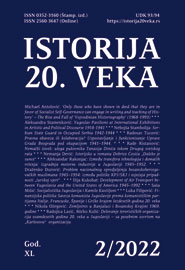SOCIJALISTIČKA JUGOSLAVIJA I KAMILO KASTILJONI
SOCIALIST YUGOSLAVIA AND CAMILLO CASTIGLIONI
Author(s): Saša MišićSubject(s): WW II and following years (1940 - 1949), Post-War period (1950 - 1989)
Published by: Institut za savremenu istoriju, Beograd
Keywords: Yugoslavia; Camillo Castiglioni; United States; Italy; Export-Import Bank; Loan; Litigation; Unsettled Claims
Summary/Abstract: After the breakup of relations with the Soviet Union and its satellites in 1948, Yugoslavia began to turn to Western countries, seeking not only formal but also informal ties for connecting with them, especially in the economic field. Italian financier Camillo Castiglioni seemed like a good choice for the role of unofficial mediator, especially because of the contacts he had with US financial circles. During 1949, the Yugoslavs hired him as an informal mediator for negotiations with the Export-Import Bank of the United States, in order to obtain a loan from this banking institution. An agreement was signed with him, in which he was promised an adequate reward for mediation. Since at the same time the official representatives of Yugoslavia and the United States were involved in the loan negotiations, and because of the indignation of the Americans over Castiglioni’s role, Belgrade quickly gave up his services. For his engagement, Castiglioni received compensation from Yugoslavia in the form of money and goods (hemp), which referred only to the costs of mediation, but did not include the promised commission. Taking advantage of the fact that he could not get the promised amount of money from the sale of hemp, Castiglioni initiated a lawsuit against Yugoslavia in an Italian court in 1951 and demanded that he be paid the difference in money, and also the amount of the promised commission. Although the court ruled in his favor that same year, Yugoslavia did not recognize the court’s decision. The next few years passed on the one hand in Castiglioni’s efforts to execute the court verdict and collect the claims, and on the other hand in the attempts of state officials in Belgrade and Rome to find a compromise solution that would satisfy the Yugoslavs. This included offers for a settlement, proposals for arbitration of an international court, and the like. The trial and the execution of the verdict took place at a time when Italy and Yugoslavia were trying to unravel the complicated knot of Trieste, so the Castiglioni case was also influenced by the situation in bilateral relations. Finally, in 1955, Castiglioni managed to collect the requested amount, which was paid off by the Italian state as a part of a broader Yugoslav-Italian agreement on war reparations.
Journal: Istorija 20. veka
- Issue Year: 2022
- Issue No: 2
- Page Range: 457-475
- Page Count: 19
- Language: Serbian

